
Company layoffs: Dispelling 4 common myths (Updated 2024)

Written by

Senior Content Marketing Manager, Culture Amp

Director of People Science Research, Culture Amp
Updated March 6, 2024. This research series originally analyzed data collected between March 1, 2020, and November 30, 2022. Our people scientists specifically re-analyzed Myth #2 using an expanded time frame (March 1, 2020 to December 31, 2023).
People have a lot of preconceptions about layoffs – some true, some unfounded, and many falling somewhere in the middle.
In Culture Amp’s work with over 6,000 companies, we’ve encountered many of these myths. Here, we’ll tackle four of the most common:
- Companies with a strong employee experience fare better following layoffs than companies with weaker employee experiences
- Layoffs are hard, but engagement levels will eventually rebound back to pre-layoff levels
- Companies have to do multiple layoffs because they didn’t “cut deep enough” in the first round
- The deeper the “cut,” the harder layoffs are on employees
But, do these hunches about layoffs hold up to the data-backed realities? In this third part of our series on rebuilding engagement after changes, we’ll examine these four common myths about layoffs and share the data behind our assertions.
Our methodology
Culture Amp’s people scientists used Layoffs.fyi to identify customers who went through layoffs between March 1, 2020, and November 30, 2022. Of these customers, 146 had conducted surveys before (Survey 1) and after (Survey 2) the layoff.
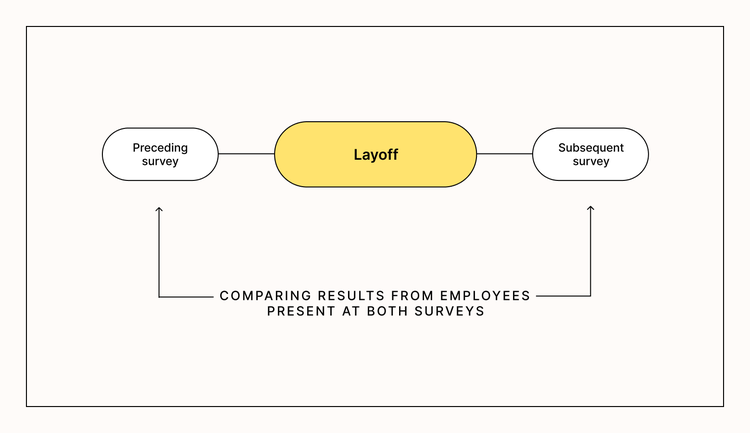
By comparing the results from the two surveys, we were able to understand some of the ways that layoffs affect employee engagement at organizations.
To establish a control group, we compared each company’s change to the global benchmark for the same time period. In other words, if a company with layoffs was first surveyed in June 2021 and then again in December 2021, we compared them to the quarterly benchmark difference for that same time period.
Note: Myth #2 has been specifically re-analyzed using an expanded datbase, adding 355 companies that went through layoffs between December 1, 2022, and December 31, 2023.
Myth #1: A great employee experience will buffer a company against increased turnover following layoffs
Truth: Companies with the highest commitment prior to a layoff see the largest declines in commitment post layoff
Although it may seem reasonable to believe that companies with the most loyal and committed employees would be less impacted than companies with less committed employees, our data indicates otherwise.
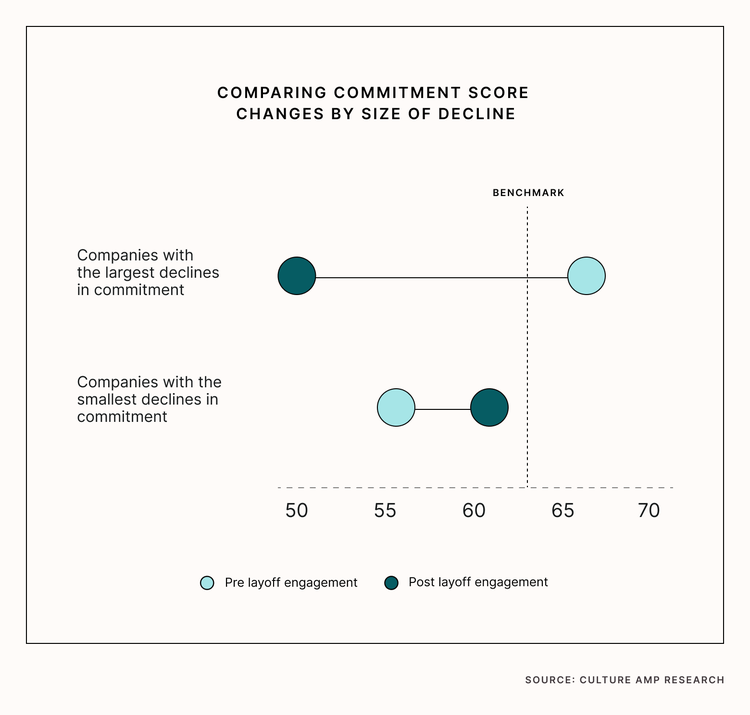
When we tried to identify companies that fared better (meaning had smaller declines in commitment to the organization) following a layoff, we found there was one thing they had in common – they were scoring below the benchmark prior to the layoffs. Moreover, some of these low-scoring companies even saw commitment levels increase after the layoff.
On the other hand, the companies that saw the largest declines in commitment scored significantly above the benchmark before the layoff, indicating that highly committed employees feel particularly hurt and betrayed when layoffs do happen.
💡Insight: The data suggests that having many committed employees prior to a layoff doesn’t decrease the risk of increased turnover (as measured by commitment) post-layoff. If anything, the layoff comes as an even greater shock to these employees, who may believe that hard work and loyalty would insulate the workforce against difficult decisions like layoffs.
Meanwhile, employees at companies with less committed employees may see layoffs as a necessary action for addressing structural and systemic problems within the organization. If employees at such companies agree with this perceived need, these companies may actually see an improvement in commitment.
Myth #2: Layoffs are hard, but engagement will eventually rebound back to pre-layoff levels
Truth: You will only see a rebound if you hire new employees
While many leaders expect employee engagement to take a nosedive after a layoff, they also believe that after some time, engagement levels will bounce back to pre-layoff levels. But is this true?
Well, using our extended dataset that includes 2023 data, we found that if we compared engagement scores prior to the layoff to survey results in the months following the layoff, we do see an “engagement rebound” happen between 18-24 months. This is different from what we found last year, in which we shared that engagement rebounds at the 12-18 month mark post-layoffs.

However, this is only true when we look at employee engagement among all employees – if we dig deeper and only look at data for employees who were present for the layoff, we encounter a different story.
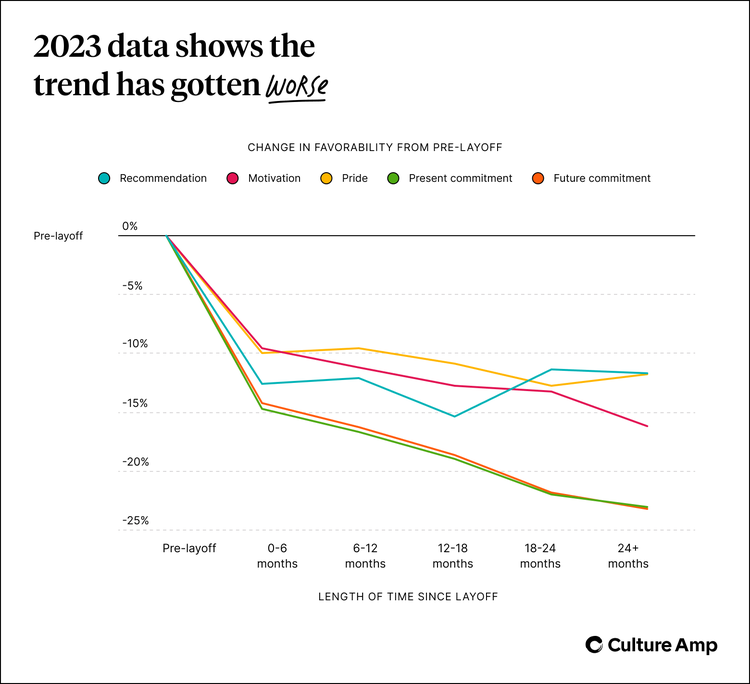
For employees who were present at the time of the layoff, engagement doesn’t return to pre-layoff levels, even after two years. Pride, commitment, and motivation plateau, while commitment continues to decline as employees become more tenured.
Taken altogether, the data demonstrate that a “post-layoff engagement rebound” only happens because organizations add new employees. Scores only seem to improve because these new employees both (1) didn’t go through the layoff and (2) are in the honeymoon phase, and respond much more positively on average than tenured employees.
💡Insight: Companies shouldn’t expect to see a rebound in engagement until they start hiring again. At that point, new employees will want to know that the organization is set up to succeed going forward, so it’s crucial for leaders to create a compelling vision for new employees, and help them understand how they can contribute to the organization’s “comeback story.”
As for tenured employees, companies should focus on understanding how these employees feel, and take action to start rebuilding engagement among those whose trust and motivation were broken by the layoff. To do this effectively, it’s important to collect employee feedback and dig into the data to pinpoint the aspects of the employee experience that are most important to these employees.
How is this different from what we saw in 2023?
We found that the decline in engagement is slightly worse than what we found in 2022. The only improvement we saw between our 2022 and 2023 analysis was around future commitment at the 18-24 months mark post-layoffs.
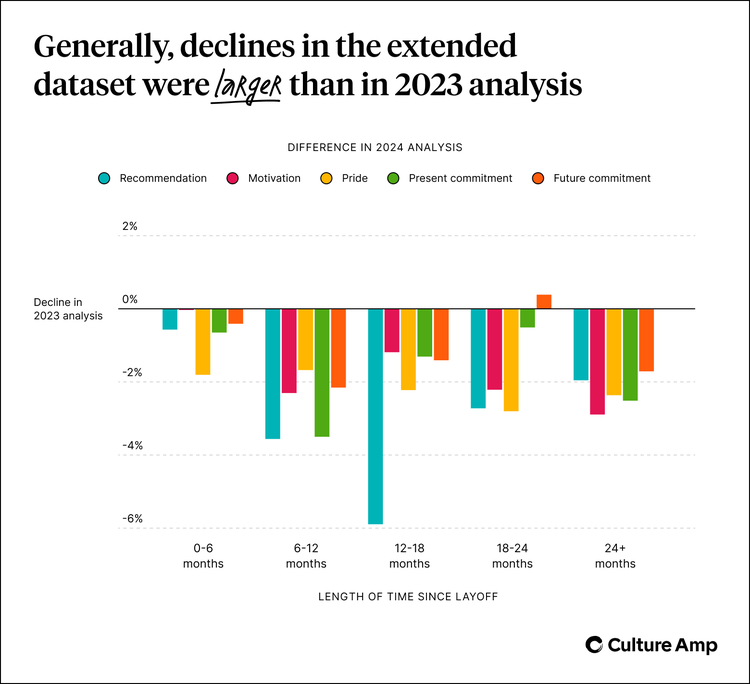
Myth #3: Companies have to do multiple layoffs because they didn’t “cut deep enough” the first round
Truth: All companies, whether they went on to do subsequent layoffs or not, on average laid off the same percentage overall
In reviewing Layoffs.fyi data from March 1, 2020, to November 30, 2022, we found the median percentage laid off was 18.5%. This was true whether a company went on to do subsequent rounds of layoffs (which 17% of the companies did) or not.
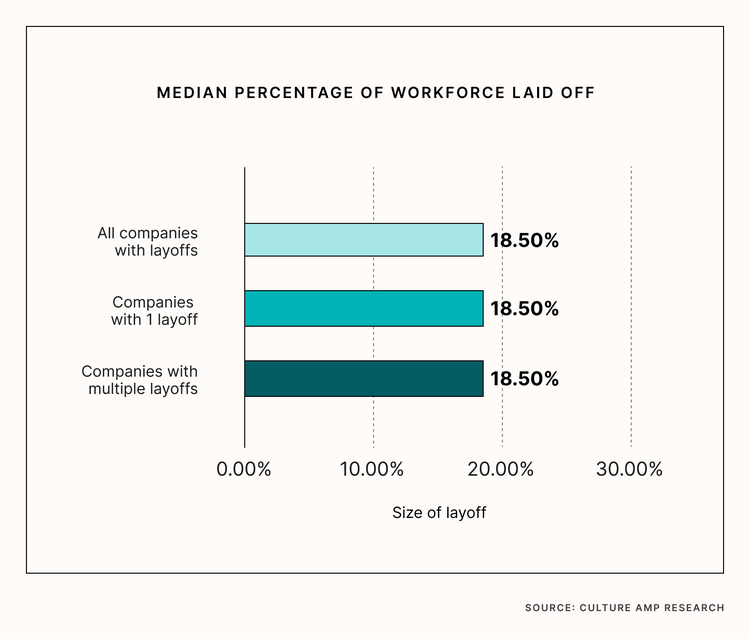
💡Insight: There is no magic layoff percentage that will make a company immune to subsequent layoffs.
Myth #4: The deeper the cut, the harder layoffs are on employees
Truth: The size of the layoff only affects how employees feel about three things: pride, commitment, and managers stepping up
The median layoff size for the 146 companies in our sample was 16%. When we divided the sample into “above-median” and “below-median” groups, we found that the size of a layoff doesn’t generally change the layoff's impact on the employee experience. In other words, when we compared companies with large versus small layoffs, we didn’t find significant differences in how much a company declined in company confidence, development, perception of leadership, etc.
However, there were three areas in which we observed a significant difference:
- Pride
- Commitment
- Perception of manager
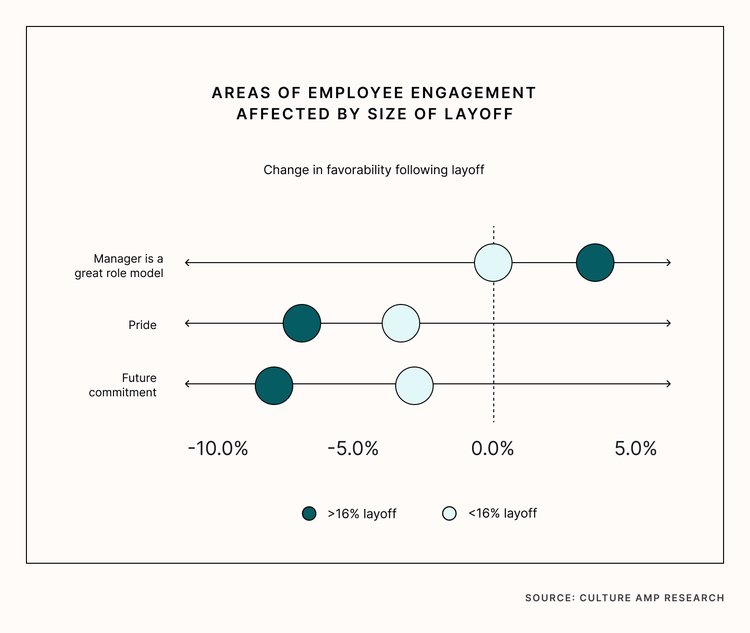
Employees at companies who go through a larger layoff decline slightly more in pride and commitment than employees whose companies went through smaller layoffs. This is likely because a larger layoff results in a more significant reputational hit for the organization, creating more uncertainty around job security.
On the other hand, one question showed the opposite pattern – managers appear to step up more and better help their teams after more extensive layoffs.
💡Insight: When going through a layoff, engagement, company confidence, perceptions of leadership, and development all take big hits, regardless of the size of the layoff. While it may seem like a larger layoff would result in more significant declines, only pride and commitment appear to be significantly affected by layoff size.
Distinguish fact from fiction with data
People approach the topic of layoffs with many preconceived notions, many of which may seem reasonable and intuitive. However, the best way to understand what’s fact and what’s fiction is to look at the data.
In this article, we busted four common misconceptions about layoffs and found:
- The mighty have further to fall. While many companies believe their strong employee experience will cushion them from potential turnover post-layoffs, they actually experience more significant declines in commitment than companies with below-benchmark scores.
- Employee engagement doesn’t rebound for employees who experience layoffs. Companies shouldn’t expect employees who have experienced a layoff to eventually “warm up” to the company again. Our data shows that scores will only improve if companies hire new employees.
- Companies, on average, lay off the same percentage of employees regardless of how many layoffs they go through. Whether a company conducts one or multiple rounds of layoffs, the median layoff percentage was 18.50% across the board.
- The size of the layoff doesn’t significantly change the impact of the layoff on employee engagement. Whether a layoff is large or small, employee engagement declines similarly for all questions besides pride, commitment, and perception of managers.
So what does this mean for leaders? First and foremost, it’s crucial to fully comprehend the impact layoffs have on employee engagement and the employee experience. There is no such thing as an “engagement rebound” following layoffs, and an otherwise excellent employee experience won’t help buffer against the impact of a layoff.
Secondly, if leaders want to improve engagement, they must prioritize it, as engagement won’t magically repair itself. Although our research shows that engagement among employees present at layoffs generally doesn’t rebound to pre-engagement levels, these numbers are just averages. Companies that prioritize their people and culture (before, through, and during layoffs) can repair engagement and morale at their organizations. By collecting feedback and approaching layoffs with empathy, you can pin-point the high-impact initiatives your people value the most.
In the next and final part of our series, we’ll shift our focus from layoffs to the impact of mergers and acquisitions on the employee experience. To understand how (and if) mergers and acquisitions affect the employee experience differently, bookmark this page or subscribe to the People Geekly newsletter.

Unlock key insights into the employee experience
Read the rest of the series:



